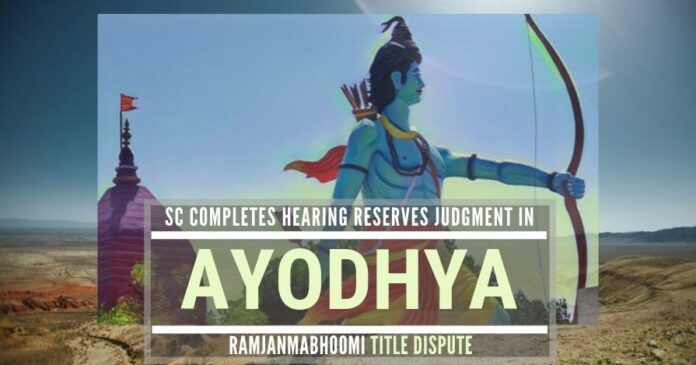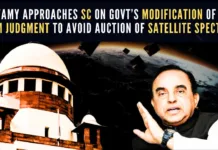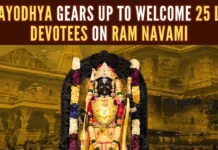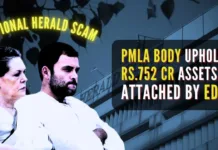
The centuries-long dispute and politically sensitive Ayodhya case concluded its hearing on Wednesday by the Supreme Court after the 40-day long day-to-day hearing. The Bench headed by Chief Justice of India (CJI) Ranjan Gogoi gave three days’ time for all parties to file written submissions if any and the Judgment will be delivered on or before November 15, the last working day of the Chief Justice.
The last day witnessed arguments being cut short and as usual the Sunni advocate Rajiv Dhawan threw tantrums. Dhawan lost his cool when Hindu Maha Sabha’s advocate Vikas Singh submitted a copy of his versions cornering the claims of Sunnis. The apex court also de-tagged BJP leader Subramanian Swamy’s writ petition on his fundamental right to worship and limited its scope to concluding the main case related to the property rights on the disputed Ram Janmabhoomi – Babri Masjid title-claiming petitions challenging the Allahabad High Court verdict of 2010.
A 5-judge Constitution bench, headed by Chief Justice Ranjan Gogoi, granted three days to the contesting parties to file written notes on ‘moulding of relief’ or narrowing down the issues on which the court is required to adjudicate. The other members of the bench are justices S A Bobde, D Y Chandrachud, Ashok Bhushan and S A Nazeer.
The Constitution Bench, which started the day-to-day proceedings on August 6 after mediation proceedings failed to find an amicable solution to the vexatious dispute, had revised the deadline for wrapping up the proceedings. Fourteen appeals have been filed in the apex court against the 2010 Allahabad High Court judgment, delivered in four civil suits, that the 2.77-acre land in Ayodhya be partitioned equally among the three parties — the Sunni Waqf Board, the Nirmohi Akhara and Ram Lalla.
Initially, as many as five lawsuits were filed in the lower court. The first one was filed by Gopal Singh Visharad, a devotee of ”Ram Lalla”, in 1950 to seek enforcement of the right to worship of Hindus at the disputed site. In the same year, the Paramahansa Ramachandra Das had also filed the lawsuit for the continuation of worship and keeping the idols under the central dome of the now-demolished disputed structure. The plea was later withdrawn.
Later, the Nirmohi Akhara also moved the trial court in 1959 seeking management and “shebaiti” (devotee) rights over the 2.77 acres disputed land. Then came the lawsuit of the Uttar Pradesh Sunni Central Wakf Board which moved the court in 1961, claiming title right over the disputed property.
The deity, ”Ram Lalla Virajman” through a friend and former Allahabad High Court judge Deoki Nandan Agrawal, and the Janambhoomi (the birthplace) moved the lawsuit in 1989, seeking title right over the entire disputed property on the key ground that the land itself has the character of the deity and of a ”Juristic entity”. Later, all the lawsuits were transferred to the Allahabad High Court for adjudication following the demolition of the disputed Ram Janmabhoomi – Babri masjid structure on December 6, 1992, sparking communal riots in the country.
The apex court had on August 6 commenced day-to-day proceedings in the case as the mediation proceedings initiated to find the amicable resolution had failed. It had taken note of the report of the three-member panel, comprising Justice F M I Kallifulla, spiritual guru and founder of the Art of Living Foundation Sri Sri Ravishankar and senior advocate and renowned mediator Sriram Panchu, that mediation proceedings, which went on for about four months, did not result in any final settlement and it had to decide the matter pending before it.
The following is the chronology of events from AD 1528 in the Ram Janmabhoomi – Babri Masjid land dispute case in Ayodhya in which the Supreme Court Wednesday concluded a 40-day hearing and reserved the order.
| T I M E L I N E | |
| 1528: | Babri Masjid built by Mir Baqi commander of Mughal emperor Babur. |
| 1885: | Mahant Raghubir Das files plea in Faizabad district court seeking permission to build a canopy outside the disputed structure. Court rejects the plea. |
| 1949: | Idols of Ram Lalla placed under central dome outside the disputed structure. |
| 1950: | Gopal Simla Visharad files suit in Faizabad district court for rights to worship the idols of Ram Lalla.
Paramahansa Ramachandra Das also files suit for the continuation of worship and keeping the idols. |
| 1959: | Nirmohi Akhara files suit seeking possession of the site. |
| 1961: | UP Sunni Central Waqf Board files suit for possession of the site. |
| Feb 1, 1986: | Local court orders the government to open the site for Hindu worshippers. |
| Aug 14, 1989: | Allahabad HC orders maintenance of the status quo in respect of the disputed structure. |
| Dec 6, 1992: | Babri Masjid demolished during the Karsevaks belong to Sangh Parivar. |
| Apr 3, 1993: | ‘Acquisition of Certain Area at Ayodhya Act’ passed for acquiring land by Centre in the disputed area. Various writ petitions, including one by Ismail Faruqui, filed in Allahabad HC challenging various aspects of the Act. SC exercising its jurisdiction under Article 139A transferred the writ petitions, which were pending in the High Court. |
| Oct 24, 1994: | SC says in Ismail Faruqui case mosque was historically not integral to Islam. |
| Apr 2002: | HC begins hearings on determining who owns the disputed site. |
| Mar 13, 2003: | SC says, in the Aslam alias Bhure case, no religious activity of any nature be allowed at the acquired land. |
| 2003: | Archeological Survey of India (ASI) team appointed by the High Court reports that Masjid was built above a temple and citing many portions of temple structures below the Masjid. |
| Sep 30, 2010: | HC, in a 2:1 majority, rules three-way division of disputed area between Sunni Waqf Board, the Nirmohi Akhara and Ram Lalla. |
| May 9, 2011: | SC stays HC verdict on Ayodhya land dispute. |
| 2015: | BJP leader Subramanian Swamy files a separate petition in Supreme Court seeking basic facilities for the pilgrims in the make-shift Ram Mandir at the disputed cite. He later files Writ Petition on Fundamental Right to Worship. The Supreme Court tags Swamy’s petition with the main case, which was pending for the past five years in the Supreme Court. |
| Nov 19, 2016: | Swamy writes to the PM, urging him to support a day-to-day hearing of the Ayodhya case, saying that all the parties involved wanted it. He requested the PM to tell the Government lawyers to support it too. |
| Mar 21, 2017: | On Swamy’s submission on his listing and immediate hearing of his petitions CJI JS Khehar suggests out-of-court settlement among rival parties first. |
| Feb 8, 2018: | SC starts hearing the civil appeals and Sunni advocate Rajiv Dhavan and Kapil Sibal created unruly scenes and demands CJI Dipak Mishra to postpone hearings after 2019 Lok Sabha elections. Meanwhile, Congress initiates Impeachment against CJI and the Apex Court agrees to Sunni’s demand to re-visit the Farooqui Judgment in September the apex court ratifies the Farooqui Judgment that Masjid is not an integral part of Islam. |
| Oct 29: | SC fixes the case for the first week of January before an appropriate bench, which will decide the schedule of hearing. |
| Dec 24: | SC decides to take up petitions on the case for hearing on January 4, 2019. |
| Jan 4, 2019: | SC says an appropriate bench constituted by it will pass an order on January 10 for fixing the date of hearing in the title case. |
| Jan 8: | SC sets up a five-judge Constitution Bench to hear the case headed by Chief Justice Ranjan Gogoi and comprising justices S A Bobde, N V Ramana, U U Lalit, and D Y Chandrachud. |
| Jan 10: | Justice U U Lalit recuses himself prompting SC to reschedule the hearing for January 29 before a new bench. |
| Jan 25: | SC reconstitutes 5-member Constitution Bench to hear the case. The new bench comprises Chief Justice Ranjan Gogoi and Justices S A Bobde, D Y Chandrachud, Ashok Bhushan and S A Nazeer. |
| Jan 29: | Centre moves SC seeking permission to return the 67-acre acquired land around the disputed site to original owners. The apex court has not yet responded to this petition by the Centre. |
| Feb 26: | SC favours mediation, fixes Mar 5 for order on whether to refer the matter to a court-appointed mediator. |
| Mar 8: | SC refers the dispute for mediation by a panel headed by former apex court judge F M I Kallifulla. |
| Apr 9: | Nirmohi Akhara opposes in SC Centre’s plea to return acquired land around Ayodhya site to owners. |
| May 9: | 3-member mediation committee submits an interim report in SC. |
| May 10: | SC extends the time till Aug 15 to complete the mediation process. |
| Jul 11: | SC seeks a report on “progress of mediation”. |
| Jul 18: | SC allows the mediation process to continue, seeks outcome report by Aug 1. |
| Aug 1: | Report of mediation submitted in a sealed cover to SC. |
| Aug 2: | SC decides to conduct day-to-day hearing from Aug 6 as mediation fails. |
| Aug 6: | SC commences day-to-day hearing on the land dispute. |
| Oct 4: | SC says it will wrap up hearing on Oct 17, judgment by Nov 15. |
| Oct 16: | SC concludes hearing and Reserves for Judgment. |
- Subramanian Swamy approaches Supreme Court on Govt’s modification of 2G Scam Judgment to avoid auction of Satellite Spectrum - April 23, 2024
- Defence Minister Rajnath Singh visits Siachen. Reviews military preparedness - April 22, 2024
- Amit Shah’s shares in the Stock Market almost doubled in the past five years - April 21, 2024











[…] Ayodhya case: Supreme Court concludes the hearing. Judgment to be delivered on or before November 15 – Oct 17, 2019, […]
Dr.Swamy is the greatest Indian ever.Good to read your updates pgurus
[…] Ayodhya case: Supreme Court concludes the hearing. Judgment to be delivered on or before November 15 – Oct 17, 2019, […]